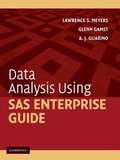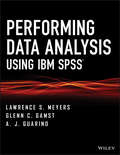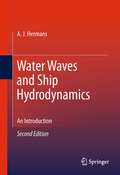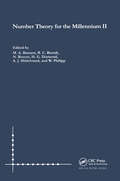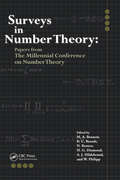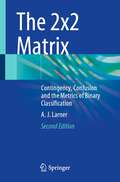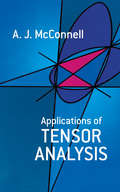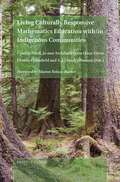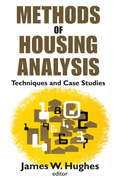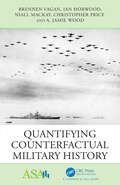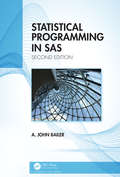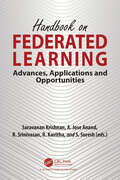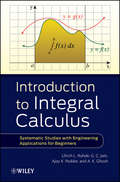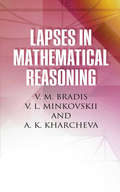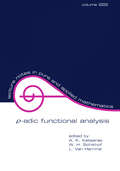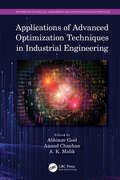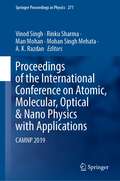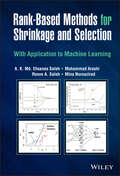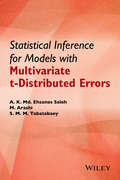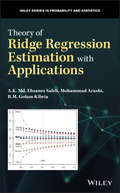- Table View
- List View
Analysis of Variance Designs
by Lawrence S. Meyers Glenn Gamst A. J. Guarino Glenn Gamst Lawrence S. MeyersANOVA (Analysis Of Variance) is one of the most fundamental and ubiquitous univariate methodologies employed by psychologists and other behavioural scientists. Analysis of Variance Designs presents the foundations of this experimental design, including assumptions, statistical significance, strength of effect, and the partitioning of the variance. Exploring the effects of one or more independent variables on a single dependent variable as well as two-way and three-way mixed designs, this textbook offers an overview of traditionally advanced topics for advanced undergraduates and graduate students in the behavioural and social sciences. Separate chapters are devoted to multiple comparisons (post hoc and planned/weighted), ANCOVA, and advanced topics. Each of the design chapters contains conceptual discussions, hand calculations, and procedures for the omnibus and simple effects analyses in both SPSS and the new 'click and shoot' SAS Enterprise Guide interface.
Data Analysis Using SAS Enterprise Guide
by Lawrence S. Meyers Glenn Gamst A. J. GuarinoThis book presents the basic procedures for utilizing SAS Enterprise Guide to analyze statistical data. SAS Enterprise Guide is a graphical user interface (point and click) to the main SAS application. Each chapter contains a brief conceptual overview and then guides the reader through concrete step-by-step examples to complete the analyses. The eleven sections of the book cover a wide range of statistical procedures including descriptive statistics, correlation and simple regression, t tests, one-way chi square, data transformations, multiple regression, analysis of variance, analysis of covariance, multivariate analysis of variance, factor analysis, and canonical correlation analysis. Designed to be used either as a stand-alone resource or as an accompaniment to a statistics course, the book offers a smooth path to statistical analysis with SAS Enterprise Guide for advanced undergraduate and beginning graduate students, as well as professionals in psychology, education, business, health, social work, sociology, and many other fields.
Data Analysis Using SAS Enterprise Guide
by Lawrence S. Meyers Glenn Gamst A. J. Guarino Lawrence S. Meyers Glenn GamstThis book presents the basic procedures for utilizing SAS Enterprise Guide to analyze statistical data. SAS Enterprise Guide is a graphical user interface (point and click) to the main SAS application. Each chapter contains a brief conceptual overview and then guides the reader through concrete step-by-step examples to complete the analyses. The eleven sections of the book cover a wide range of statistical procedures including descriptive statistics, correlation and simple regression, t tests, one-way chi square, data transformations, multiple regression, analysis of variance, analysis of covariance, multivariate analysis of variance, factor analysis, and canonical correlation analysis. Designed to be used either as a stand-alone resource or as an accompaniment to a statistics course, the book offers a smooth path to statistical analysis with SAS Enterprise Guide for advanced undergraduate and beginning graduate students, as well as professionals in psychology, education, business, health, social work, sociology, and many other fields.
Performing Data Analysis Using IBM SPSS
by Lawrence S. Meyers A. J. Guarino Glenn C. GamstFeatures easy-to-follow insight and clear guidelines to perform data analysis using IBM SPSS®Performing Data Analysis Using IBM SPSS® uniquely addresses the presented statistical procedures with an example problem, detailed analysis, and the related data sets. Data entry procedures, variable naming, and step-by-step instructions for all analyses are provided in addition to IBM SPSS point-and-click methods, including details on how to view and manipulate output.Designed as a user's guide for students and other interested readers to perform statistical data analysis with IBM SPSS, this book addresses the needs, level of sophistication, and interest in introductory statistical methodology on the part of readers in social and behavioral science, business, health-related, and education programs. Each chapter of Performing Data Analysis Using IBM SPSS covers a particular statistical procedure and offers the following: an example problem or analysis goal, together with a data set; IBM SPSS analysis with step-by-step analysis setup and accompanying screen shots; and IBM SPSS output with screen shots and narrative on how to read or interpret the results of the analysis.The book provides in-depth chapter coverage of:IBM SPSS statistical outputDescriptive statistics proceduresScore distribution assumption evaluationsBivariate correlationRegressing (predicting) quantitative and categorical variablesSurvival analysist TestANOVA and ANCOVAMultivariate group differencesMultidimensional scalingCluster analysisNonparametric procedures for frequency dataPerforming Data Analysis Using IBM SPSS is an excellent text for upper-undergraduate and graduate-level students in courses on social, behavioral, and health sciences as well as secondary education, research design, and statistics. Also an excellent reference, the book is ideal for professionals and researchers in the social, behavioral, and health sciences; applied statisticians; and practitioners working in industry.
Water Waves and Ship Hydrodynamics: An Introduction
by A. J. HermansIn this book an introduction is given to aspects of water waves that play a role in ship hydrodynamics and offshore engineering. At first the equations and linearized boundary conditions are derived describing the non-viscous free surface water waves, with special attention to the combination of steady and non-steady flow fields. Then some simple kinds of free wave solutions are derived, such as plane waves and cylindrical waves. For several situations, steady and unsteady, the source singularity function is derived. These functions play a role in numerical codes used to describe the motion of ships and offshore structures. These codes are mostly based on a boundary integral formulation; therefore we give an introduction to these methods. It is shown how first order ship motions can be determined. In offshore engineering the second order wave drift motions play an important role. An introduction to this phenomenon is given and the effects which have to be taken into account are explained by means of a simple example where we can determine nearly all the aspects analytically. An interesting example that is worked out is the motion of very large floating flexible platforms with finite draft. Finally an introduction to the theory of shallow water non-linear dispersive waves is presented, and shallow water ship hydrodynamics, that plays a role in coastal areas and channels is treated. Here attention is paid to the interaction between passing ships in restricted water. In the appendix a short introduction to some of the mathematical tools is given.
Number Theory for the Millennium II
by M. A. Bennett N. Boston H. G. Diamond A. J. Hildebrand B. C. Berndt W PhilippBuilding on the tradition of an outstanding series of conferences at the University of Illinois at Urbana-Champaign, the organizers attracted an international group of scholars to open the new Millennium with a conference that reviewed the current state of number theory research and pointed to future directions in the field. The conference was the largest general number theory conference in recent history, featuring a total of 159 talks, with the plenary lectures given by George Andrews, Jean Bourgain, Kevin Ford, Ron Graham, Andrew Granville, Roger Heath-Brown, Christopher Hooley, Winnie Li, Kumar Murty, Mel Nathanson, Ken Ono, Carl Pomerance, Bjorn Poonen, Wolfgang Schmidt, Chris Skinner, K. Soundararajan, Robert Tijdeman, Robert Vaughan, and Hugh Williams. The Proceedings Volumes of the conference review some of the major number theory achievements of this century and to chart some of the directions in which the subject will be heading during the new century. These volumes will serve as a useful reference to researchers in the area and an introduction to topics of current interest in number theory for a general audience in mathematics.
Surveys in Number Theory: Papers from the Millennial Conference on Number Theory
by M. A. Bennett N. Boston H. G. Diamond A. J. Hildebrand B. C. Berndt W PhilippThis volume, based on fourteen papers from the Millennial Conference on Number Theory, represents surveys of topics in number theory and provides an outlook into the future of number theory research. It serves as an inspiration to graduate students and as a reference for research mathematicians.
The 2x2 Matrix: Contingency, Confusion and the Metrics of Binary Classification
by A. J. LarnerThis book describes, extends, and illustrates the metrics of binary classification through worked examples.Worked examples based on pragmatic test accuracy study data are used in chapters to illustrate relevance to day-to-day clinical practice. Readers will gain an understanding of sensitivity and specificity and predictive values along with many other parameters.The contents are highly structured, and the use of worked examples facilitates understanding and interpretation.This book is a resource for clinicians in any discipline who are involved in the performance or assessment of test accuracy studies and professionals in the disciplines of machine learning or informatics wishing to gain insight into clinical applications of 2x2 tables.
Applications of Tensor Analysis (Dover Books on Mathematics)
by A. J. McConnellThis standard work applies tensorial methods to subjects within the realm of advanced college mathematics. In its four main divisions, it explains the fundamental ideas and the notation of tensor theory; covers the geometrical treatment of tensor algebra; introduces the theory of the differentiation of tensors; and applies mathematics to dynamics, electricity, elasticity, and hydrodynamics.Partial contents: algebraic preliminaries (notation, definitions, determinants, tensor analysis); algebraic geometry (rectilinear coordinates, the plane, the straight line, the quadric cone and the conic, systems of cones and conics, central quadrics, the general quadric, affine transformations); differential geometry (curvilinear coordinates, covariant differentiation, curves in a space, intrinsic geometry of a surface, fundamental formulae of a surface, curves on a surface); applied mathematics (dynamics of a particles, dynamics of rigid bodies, electricity and magnetism, mechanics of continuous media, special theory of relativity).
Living Culturally Responsive Mathematics Education With/in Indigenous Communities
by Cynthia Nicol Jo-Ann Archibald Q'Um Q'Um Xii Florence Glanfield A. J. Sandy DawsonLiving Culturally Responsive Mathematics Education with/in Indigenous Communities explores challenges and possibilities across international contexts, involving Indigenous and non-Indigenous scholars, teachers and Elders responding to calls for improved education for all Indigenous students. Authors from Australia, New Zealand, United States, Micronesia, and Canada explore the nature of culturally responsive mathematics education. Chapters highlight the importance of relationships with communities and the land, each engaging critically with ideas of culturally responsive education, exploring what this stance might mean and how it is lived in local contexts within global conversations. Education researchers and teacher educators will find a living pathway where scholars, educators, youth and community members critically take-up culturally responsive teachings and the possibilities and challenges that arise along the journey.
O-Minimality and Diophantine Geometry
by G. O. Jones A. J. WilkieThis collection of articles, originating from a short course held at the University of Manchester, explores the ideas behind Pila's proof of the Andre-Oort conjecture for products of modular curves. The basic strategy has three main ingredients: the Pila-Wilkie theorem, bounds on Galois orbits, and functional transcendence results. All of these topics are covered in this volume, making it ideal for researchers wishing to keep up to date with the latest developments in the field. Original papers are combined with background articles in both the number theoretic and model theoretic aspects of the subject. These include Martin Orr's survey of abelian varieties, Christopher Daw's introduction to Shimura varieties, and Jacob Tsimerman's proof via o-minimality of Ax's theorem on the functional case of Schanuel's conjecture.
Methods of Housing Analysis: Techniques and Case Studies
by A. James GregorIn order to understand and formulate housing policy and programs, it is necessary to have a working knowledge of the internal economic operation of housing from the points of view of both the investor and the owner. James W. Hughes argues that investors' and owners' behavior and activity tend to be governed by market forces and other realities. In that regard, he begins this work by analyzing market rates of return in real estate and housing undertakings, and the variety of analytical techniques which underlie their determination.Methods of Housing Analysis is designed to provide urban planners with an introduction to the basic, quantitative techniques associated with the analysis of housing. A myriad of specific analytical methods has evolved in each of the professions concerned with this subject area. Planners, investors, developers, engineers, appraisers, social scientists, and governmental officials all tend to exhibit unique perspectives when examining housing and have developed their analytical frameworks accordingly.The work is comprised of an extensive discussion by the author, detailed case studies and examples, and a number of essays by leading experts that detail specific analytical procedures and demonstrate their use. The book is divided into four major sections: analysis of the internal operation of housing; basic cost-revenue analysis; expanded cost-revenue/benefit analysis; and government regulation of housing. The thorough nature of Hughes' discussion and of the related readings makes this volume an ideal textbook and reference source.
Quantifying Counterfactual Military History (ASA-CRC Series on Statistical Reasoning in Science and Society)
by Christopher Price Brennen Fagan Ian Horwood Niall MacKay A. Jamie WoodForces shaping human history are complex, but the course of history is undeniably changed on many occasions by conscious acts. These may be premeditated or responsive, calmly calculated or performed under great pressure. They may also be successful or catastrophic, but how are historians to make such judgements and appeal to evidence in support of their conclusions? Further, and crucially, how exactly are we to distinguish probable unrealized alternatives from improbable ones? This book describes some of the modern statistical techniques that can begin to answer this question, as well as some of the difficulties in doing so. Using simple, wellquantified cases drawn from military history, we claim that statistics can now help us to navigate the near-truths, the envelope around the events with which any meaningful historical analysis must deal, and to quantify the basis of such analysis. Quantifying Counterfactual Military History is intended for a general audience who are interested in learning more about statistical methods both in military history and for wider applications. Key Features: This book demonstrates how modern statistical techniques can measure the impact of counterfactual decisions. It examines the importance of counterfactual reasoning for both modern scholars and historical actors. It combines historical narrative, mathematical precision and data to create a straightforward presentation of both factual and counterfactual military history. It provides an original contribution to the debate over the validity and rigour of works of counterfactual history. It is written in a manner accessible to readers who have no formal training in History or Statistics.
Statistical Programming in SAS
by A. John BailerStatistical Programming in SAS Second Edition provides a foundation for programming to implement statistical solutions using SAS, a system that has been used to solve data analytic problems for more than 40 years. The author includes motivating examples to inspire readers to generate programming solutions. Upper-level undergraduates, beginning graduate students, and professionals involved in generating programming solutions for data-analytic problems will benefit from this book. The ideal background for a reader is some background in regression modeling and introductory experience with computer programming. The coverage of statistical programming in the second edition includes Getting data into the SAS system, engineering new features, and formatting variables Writing readable and well-documented code Structuring, implementing, and debugging programs that are well documented Creating solutions to novel problems Combining data sources, extracting parts of data sets, and reshaping data sets as needed for other analyses Generating general solutions using macros Customizing output Producing insight-inspiring data visualizations Parsing, processing, and analyzing text Programming solutions using matrices and connecting to R Processing text Programming with matrices Connecting SAS with R Covering topics that are part of both base and certification exams.
Handbook on Federated Learning: Advances, Applications and Opportunities
by S. Suresh R. Srinivasan Saravanan Krishnan A. Jose Anand R. KavithaMobile, wearable, and self-driving telephones are just a few examples of modern distributed networks that generate enormous amount of information every day. Due to the growing computing capacity of these devices as well as concerns over the transfer of private information, it has become important to process the part of the data locally by moving the learning methods and computing to the border of devices. Federated learning has developed as a model of education in these situations. Federated learning (FL) is an expert form of decentralized machine learning (ML). It is essential in areas like privacy, large-scale machine education and distribution. It is also based on the current stage of ICT and new hardware technology and is the next generation of artificial intelligence (AI). In FL, central ML model is built with all the data available in a centralised environment in the traditional machine learning. It works without problems when the predictions can be served by a central server. Users require fast responses in mobile computing, but the model processing happens at the sight of the server, thus taking too long. The model can be placed in the end-user device, but continuous learning is a challenge to overcome, as models are programmed in a complete dataset and the end-user device lacks access to the entire data package. Another challenge with traditional machine learning is that user data is aggregated at a central location where it violates local privacy policies laws and make the data more vulnerable to data violation. This book provides a comprehensive approach in federated learning for various aspects.
Introduction to Differential Calculus
by Ulrich L. Rohde G. C. Jain Ajay K. Poddar A. K. GhoshEnables readers to apply the fundamentals of differential calculus to solve real-life problems in engineering and the physical sciences Introduction to Differential Calculus fully engages readers by presenting the fundamental theories and methods of differential calculus and then showcasing how the discussed concepts can be applied to real-world problems in engineering and the physical sciences. With its easy-to-follow style and accessible explanations, the book sets a solid foundation before advancing to specific calculus methods, demonstrating the connections between differential calculus theory and its applications. The first five chapters introduce underlying concepts such as algebra, geometry, coordinate geometry, and trigonometry. Subsequent chapters present a broad range of theories, methods, and applications in differential calculus, including: Concepts of function, continuity, and derivative Properties of exponential and logarithmic function Inverse trigonometric functions and their properties Derivatives of higher order Methods to find maximum and minimum values of a function Hyperbolic functions and their properties Readers are equipped with the necessary tools to quickly learn how to understand a broad range of current problems throughout the physical sciences and engineering that can only be solved with calculus. Examples throughout provide practical guidance, and practice problems and exercises allow for further development and fine-tuning of various calculus skills. Introduction to Differential Calculus is an excellent book for upper-undergraduate calculus courses and is also an ideal reference for students and professionals alike who would like to gain a further understanding of the use of calculus to solve problems in a simplified manner.
Introduction to Integral Calculus
by Ulrich L. Rohde G. C. Jain Ajay K. Poddar A. K. GhoshAn accessible introduction to the fundamentals of calculus needed to solve current problems in engineering and the physical sciences I ntegration is an important function of calculus, and Introduction to Integral Calculus combines fundamental concepts with scientific problems to develop intuition and skills for solving mathematical problems related to engineering and the physical sciences. The authors provide a solid introduction to integral calculus and feature applications of integration, solutions of differential equations, and evaluation methods. With logical organization coupled with clear, simple explanations, the authors reinforce new concepts to progressively build skills and knowledge, and numerous real-world examples as well as intriguing applications help readers to better understand the connections between the theory of calculus and practical problem solving. The first six chapters address the prerequisites needed to understand the principles of integral calculus and explore such topics as anti-derivatives, methods of converting integrals into standard form, and the concept of area. Next, the authors review numerous methods and applications of integral calculus, including: Mastering and applying the first and second fundamental theorems of calculus to compute definite integrals Defining the natural logarithmic function using calculus Evaluating definite integrals Calculating plane areas bounded by curves Applying basic concepts of differential equations to solve ordinary differential equations With this book as their guide, readers quickly learn to solve a broad range of current problems throughout the physical sciences and engineering that can only be solved with calculus. Examples throughout provide practical guidance, and practice problems and exercises allow for further development and fine-tuning of various calculus skills. Introduction to Integral Calculus is an excellent book for upper-undergraduate calculus courses and is also an ideal reference for students and professionals who would like to gain a further understanding of the use of calculus to solve problems in a simplified manner.
Quantum Hamilton-Jacobi Formalism (SpringerBriefs in Physics)
by A. K. Kapoor Prasanta K. Panigrahi S. Sree RanjaniThis book describes the Hamilton-Jacobi formalism of quantum mechanics, which allowscomputation of eigenvalues of quantum mechanical potential problems without solving for thewave function. The examples presented include exotic potentials such as quasi-exactly solvablemodels and Lame an dassociated Lame potentials. A careful application of boundary conditionsoffers an insight into the nature of solutions of several potential models. Advancedundergraduates having knowledge of complex variables and quantum mechanics will find thisas an interesting method to obtain the eigenvalues and eigen-functions. The discussion oncomplex zeros of the wave function gives intriguing new results which are relevant foradvanced students and young researchers. Moreover, a few open problems in research arediscussed as well, which pose a challenge to the mathematically oriented readers.
Lapses in Mathematical Reasoning (Dover Books on Mathematics)
by A. K. Kharcheva L. Minkovskii V. M. BradisDesigned as a method for teaching correct mathematical thinking to high school students, this book contains a brilliantly constructed series of what the authors call "lapses," erroneous statements that are part of a larger mathematical argument. These lapses lead to sophism or mathematical absurdities. The ingenious idea behind this technique is to lead the student deliberately toward a clearly false conclusion. The teacher and student then go back and analyze the lapse as a way to correct the problem.The authors begin by focusing on exercises in refuting erroneous mathematical arguments and their classification. The remaining chapters discuss examples of false arguments in arithmetic, algebra, geometry, trigonometry, and approximate computations. Ideally, students will come to the correct insights and conclusions on their own; however, each argument is followed by a detailed analysis of the false reasoning. Stimulating and unique, this book is an intriguing and enjoyable way to teach students critical mathematical reasoning skills.
P-Adic Functional Analysis
by A. K. Kstsaras W. H. Schikhof L. Van HammeThis volume collects together lectures presented at the Sixth International Conference held at the University of Ioannina, Greece, on p-adic functional analysis with applications in the fields of physics, differential equations, number theory, probability theory, dynamical systems, and algebraic number fields. It discusses the commutation relation AB-BA=I and its central role in quantum mechanics.
Applications of Advanced Optimization Techniques in Industrial Engineering (Information Technology, Management and Operations Research Practices)
by Abhinav Goel Anand Chauhan A. K. MalikThis book provides different approaches used to analyze, draw attention, and provide an understanding of the advancements in the optimization field across the globe. It brings all of the latest methodologies, tools, and techniques related to optimization and industrial engineering into a single volume to build insights towards the latest advancements in various domains. Applications of Advanced Optimization Techniques in Industrial Engineering includes the basic concept of optimization, techniques, and applications related to industrial engineering. Concepts are introduced in a sequential way along with explanations, illustrations, and solved examples. The book goes on to explore applications of operations research and covers empirical properties of a variety of engineering disciplines. It presents network scheduling, production planning, industrial and manufacturing system issues, and their implications in the real world. The book caters to academicians, researchers, professionals in inventory analytics, business analytics, investment managers, finance firms, storage-related managers, and engineers working in engineering industries and data management fields.
Proceedings of the International Conference on Atomic, Molecular, Optical & Nano Physics with Applications: CAMNP 2019 (Springer Proceedings in Physics #271)
by Man Mohan Vinod Singh Rinku Sharma Mohan Singh Mehata A. K. RazdanThis book highlights the proceedings of the International Conference on Atomic, Molecular, Optical and Nano-Physics with Applications (CAMNP 2019), organized by the Department of Applied Physics, Delhi Technological University, New Delhi, India. It presents experimental and theoretical studies of atoms, ions, molecules and nanostructures both at the fundamental level and on the application side using advanced technology. It highlights how modern tools of high-field and ultra-fast physics are no longer merely used to observe nature but can be used to reshape and redirect atoms, molecules, particles or radiation. It brings together leading researchers and professionals on the field to present and discuss the latest finding in the following areas, but not limited to: Atomic and Molecular Structure, Collision Processes, Data Production and Applications Spectroscopy of Solar and Stellar Plasma Intense Field, Short Pulse Laser and Atto-Second Physics Laser Technology, Quantum Optics and applications Bose Einstein condensation Nanomaterials and Nanoscience Nanobiotechnolgy and Nanophotonics Nano and Micro-Electronics Computational Condensed Matter Physics
Rank-Based Methods for Shrinkage and Selection: With Application to Machine Learning
by Mohammad Arashi A. K. Saleh Resve A. Saleh Mina NorouziradRank-Based Methods for Shrinkage and Selection A practical and hands-on guide to the theory and methodology of statistical estimation based on rank Robust statistics is an important field in contemporary mathematics and applied statistical methods. Rank-Based Methods for Shrinkage and Selection: With Application to Machine Learning describes techniques to produce higher quality data analysis in shrinkage and subset selection to obtain parsimonious models with outlier-free prediction. This book is intended for statisticians, economists, biostatisticians, data scientists and graduate students. Rank-Based Methods for Shrinkage and Selection elaborates on rank-based theory and application in machine learning to robustify the least squares methodology. It also includes: Development of rank theory and application of shrinkage and selection Methodology for robust data science using penalized rank estimators Theory and methods of penalized rank dispersion for ridge, LASSO and Enet Topics include Liu regression, high-dimension, and AR(p) Novel rank-based logistic regression and neural networks Problem sets include R code to demonstrate its use in machine learning
Statistical Inference for Models with Multivariate t-Distributed Errors
by Mohammad Arashi S M Tabatabaey A. K. SalehThis book summarizes the results of various models under normal theory with a brief review of the literature. Statistical Inference for Models with Multivariate t-Distributed Errors:Includes a wide array of applications for the analysis of multivariate observationsEmphasizes the development of linear statistical models with applications to engineering, the physical sciences, and mathematicsContains an up-to-date bibliography featuring the latest trends and advances in the field to provide a collective source for research on the topicAddresses linear regression models with non-normal errors with practical real-world examplesUniquely addresses regression models in Student's t-distributed errors and t-modelsSupplemented with an Instructor's Solutions Manual, which is available via written request by the Publisher
Theory of Ridge Regression Estimation with Applications (Wiley Series in Probability and Statistics)
by Mohammad Arashi A. K. Saleh Golam KibriaA guide to the systematic analytical results for ridge, LASSO, preliminary test, and Stein-type estimators with applications Theory of Ridge Regression Estimation with Applications offers a comprehensive guide to the theory and methods of estimation. Ridge regression and LASSO are at the center of all penalty estimators in a range of standard models that are used in many applied statistical analyses. Written by noted experts in the field, the book contains a thorough introduction to penalty and shrinkage estimation and explores the role that ridge, LASSO, and logistic regression play in the computer intensive area of neural network and big data analysis. Designed to be accessible, the book presents detailed coverage of the basic terminology related to various models such as the location and simple linear models, normal and rank theory-based ridge, LASSO, preliminary test and Stein-type estimators. The authors also include problem sets to enhance learning. This book is a volume in the Wiley Series in Probability and Statistics series that provides essential and invaluable reading for all statisticians. This important resource: Offers theoretical coverage and computer-intensive applications of the procedures presented Contains solutions and alternate methods for prediction accuracy and selecting model procedures Presents the first book to focus on ridge regression and unifies past research with current methodology Uses R throughout the text and includes a companion website containing convenient data sets Written for graduate students, practitioners, and researchers in various fields of science, Theory of Ridge Regression Estimation with Applications is an authoritative guide to the theory and methodology of statistical estimation.

